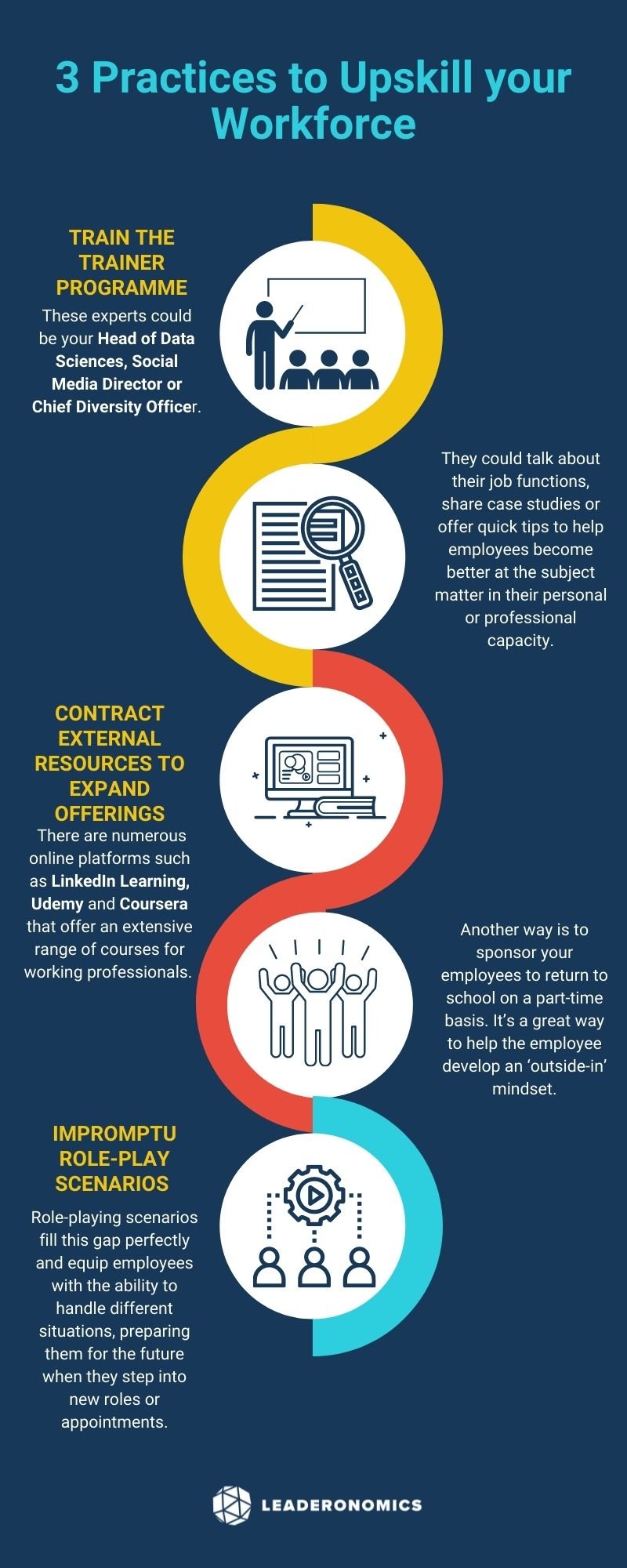How to Use Technology to Upskill your Workforce

Image by Headway on Unsplash
Much has changed over the past two years and the global workforce has been forced to quickly adapt or risk being left behind.
Employees and employers alike have converted their homes to offices as hybrid work has now become the norm. Undeniably, digital transformation has taken place on an unprecedented scale and many people are starting to adopt new technologies such as Zoom and Slack so that they can work at home more effectively.
Read More: Are Offices Obsolete?
The majority of workers who embraced technology enjoyed more opportunities or made career switches to the digital field. Others who didn’t have the chance to do so or are hesitant of changes saw salary and bonus freezes, or even unemployment.
With the pandemic raging on and no visible end in sight, it is time to get out of our self-survival mode and learn how to live in this digital-first era.
Related:
Is upskilling the only way to drive innovation?
Upskilling your workforce has become an absolute necessity in the modern context. Employees need to gain the knowledge and skills to keep pace with the dynamic changes and new technologies emerging in their workplace.
And while much importance is placed on technical skills like coding and data analytics, non-technical skills such as leadership or communication skills similarly require constant updating and learning. The goal of a holistic upskilling strategy is to ensure that your workforce is technically competent to use new software and hardware as well as work collaboratively together.
Trained employees are able to leverage new technologies to complete their work faster with higher accuracy and are also more prepared to take on higher positions that require strategic thinking and strong management skills.
To effectively manage your workforce and boost your organisational productivity, upskilling your workforce is a sure way for everyone to keep up with your innovation strategies.
Upskilling is no new fad, but the pandemic has definitely accelerated it.
According to the Randstad Workmonitor Survey, 96% of Malaysian respondents feel the need to keep learning and developing themselves in order to retain or increase their employability. 89% of respondents also admit that the changes in the job market have made them realise that they need more training and development to stay relevant.
Providing upskilling opportunities not only improves the qualifications of employees, but also enhances the company’s ability to attract new talent. Randstad Malaysia Employer Brand Research found that 41% of respondents are attracted to employers that provide employee training programmes.
Inertia to learn and technical issues are common reasons why people don’t upskill
Despite understanding its benefits, upskilling is easier said than done for many people. 61% of respondents in the Randstad Workmonitor Survey admitted that it has been a struggle to acquire new skills in their current role to adapt to the COVID-19 pandemic.
Learning should be an easy and accessible process. Much of the challenge faced by HR professionals now is how to upskill your workforce when everyone is working remotely.
Just as schools and universities have pivoted to online learning, so too should learning and development be for working professionals. However, the unprecedented scale required in orchestrating online training has presented some difficulties - a lack of resources, technical difficulties and software incompatibility are just some of the common problems that HR professionals encounter.
Furthermore, there is a general inertia observed in both employers and employees to put effort into learning new skills, particularly when everyone is busy meeting work deadlines. A study of 10,000 employees at an Asian tech company found that productivity when working from home declined by up to a fifth and output fell despite working longer hours. Even for the most industrious of us, finding time to upskill when you’re already swarmed with work could be extremely challenging.
Read More: Make Time for Learning in your Busy Life
Both offline and online training obviously offer very distinct and different experiences - hence our expectations of these two learning channels have to be different. In a classroom environment, it is easy to have the full attention of everyone who is present. However, in an online environment, you won’t really know if your employee is really paying attention to you or replying to emails behind their screens.
Adjusting to this new working environment requires some getting used to and we should expect learning efficiency to fluctuate when everyone is working online instead of in-person.
How much learning flexibility should we give to our employees?
Seeing that upskilling benefits both employees and employers, the question then arises: does the responsibility to upskill and develop lie on the employer or the employee?
The answer actually lies somewhere in between.
On one hand, employers have to provide the resources and build a conducive learning environment to make it easier for employees to grow. On the other hand, employees need to take the initiative and be responsible for their own learning opportunities.
Make it easy for your employees to learn
It is important to create a digital learning ecosystem with good usability and accessibility. For example, having a depository of all learning resources that employees can access any time allows them to look up information that they might have missed out on. Optimising the use of video conferencing tools is also important to facilitate communication and collaboration - skills that are often neglected when working from home.
Undoubtedly, learning can be exhausting and feel like a chore. To make learning more fun and less dull, change it up and gamify the learning process to motivate your employees. Games will help build team spirit among employees as well as increase engagement and participation, improving employees’ attitudes toward learning.
Create an environment where it’s okay for employees to step out of their boundaries
A very big part about learning is curiosity. 70% of learning takes place on-the-job and it is up to the employees how much they want to take advantage of those learning opportunities.
Proactivity is the name of the game when it comes to learning - and most employees value the chance to raise their hands to work on new projects or resolve problems that the business is facing. Give your staff more autonomy so that they have more opportunities to develop solutions by themselves.
Ultimately, it takes two hands to clap and creating a conducive learning environment is a holistic effort that requires both employees and employers to play a part.
Creative options to maximise the learning experience:
We’ve given you the big picture of why learning is important to strengthening your human capital and how it could look like, but how would they be implemented in real life? And most importantly, how can we use technology to make learning easier?
Here are some best practices you can take inspiration from:
1) Train the trainer programme
Upskilling an entire workforce is a tough task and it can be very costly and time consuming. This is where the “train-the-trainer” programme comes in - where subject matter experts within the organisation can impart their learnings, knowledge and expertise to their co-workers.
These experts could be your Head of Data Sciences, Social Media Director or Chief Diversity Officer. They could talk about their job functions, share case studies or offer quick tips to help employees become better at the subject matter in their personal or professional capacity. These programmes ensure that an organisation has the resources to train employees at scale and keeps the upskilling process sustainable in the long-term.
2) Contract external resources to expand offerings
If internal training programmes are insufficient, contacting external resources to expand upskilling offerings could be a viable alternative. There are numerous online platforms such as LinkedIn Learning, Udemy and Coursera that offer an extensive range of courses for working professionals.
Such external resources are accessible anytime and employees have the flexibility and autonomy to upskill in their own time. The flexibility afforded ensures that employees would not have to feel torn between work commitments and personal development, and helps to overcome the inertia to upskill.
Furthermore, these platforms constantly update their course offerings to keep up with market trends, ensuring that the skills of employees remain relevant. To further incentivise employees to upskill, companies can grant their employees learning credits which can be used to purchase more programmes from online course providers.
Another way is to sponsor your employees to return to school on a part-time basis. It’s a great way to help the employee develop an ‘outside-in’ mindset. Employees will usually be grateful for the sponsorship and hence more likely to remain a loyal employee.
3) Impromptu role-play scenarios
Creating scenarios for impromptu role-plays might seem odd and out of place in a professional setting but hear us out.
Experiencing new situations is crucial for development but such learning opportunities don’t happen often at work. For example, how to deal with a client who only calls you at 10pm or how to manage a sensitive situation where a customer has been scammed.
Role-playing scenarios fill this gap perfectly and equip employees with the ability to handle different situations, preparing them for the future when they step into new roles or appointments.

Infographic by Leaderonomics: 3 Practices to Upskill your Workforce
Be creative and flexible in upskilling your workforce
The accelerated digitalisation brought about by the pandemic has forced working professionals around the world to reconsider the way we absorb knowledge.
Although training and development programmes are generally offered to most employees, they remain one of the most underused benefits. To help your workforce stay relevant and competitive, you should regularly communicate your learning and development offerings to your employees so that more people will feel motivated to leverage them, especially if they are gunning for their next promotion.
Learning is a lifelong process and it’s also the only way that we can become better at what we do and achieve our career aspirations. It’s time that we learn to embrace the challenges that come our way and adapt our upskilling processes for the next normal.
Related:
Keep up in this ever-changing world by constant learning. Check out Necole. Necole is an Artificial Intelligence (AI) powered learning app that that curates personalised learning just for you.
Business
Tags: Talent Development, Transformation & Change, Growth Mindset





